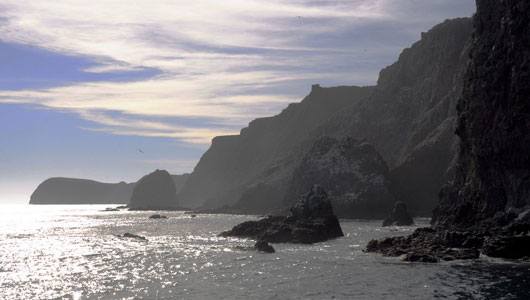
By Clint Williams
A trip to Channel Islands National Park is a trip back in time — Southern California before freeways. The park protects five islands and the surrounding waters of Pacific Ocean — preserving the breeding grounds of sea birds and elephant seals. Plants and animals found nowhere else in the world survive and , in some cases, thrive here. The evolutionary isolation of the Channel Islands has prompted some to call them the Galapagos Islands of North America.
You won’t find giant tortoises here, but it’s easy to find yourself alone.
History
President Franklin D. Roosevelt placed two of the five islands that now comprise Channel Islands National Park — Anacapa Island and Santa Barbara Island — under federal protection in 1938 when he named them national monuments. The U.S. Congress on March 5, 1980, created Channel Islands National Park, which includes San Miguel Island, Santa Rosa Island, Santa Cruz Island, Anacapa Island, Santa Barbara Island, and the submerged lands and waters within one nautical mile of each island.
Things to do
Getting to Channel Islands National Park is part of the adventure. The islands are accessible only by air or boat. Anacapa Island, the closest of the five islands, is 12 miles from the harbor in Oxnard and about an hour away by tour boat.
Hiking is limited on Anacapa Island, but the trails are flat once you climb the 200 stairs leading up from the East Anacapa Landing Cove. A 1.5-mile roundtrip to Inspiration Point offers dramatic views.
A strenuous 2.5-mile hike on Santa Barbara Island pays off with a view of elephant seals. There are a total of five miles of hiking trails on the island.
Why you’ll want to come back
Frenchy's Cove on Anacapa Island is just one of many spots rich with tidal pools choked with anemones, sea stars, urchins, limpets, periwinkles, chitons, barnacles and mussels.
Flora and fauna
The swaying kelp forests in the cold Pacific Ocean waters off the five islands provide food and shelter to a variety of marine life: black-and-yellow rockfish, bright orange garibaldi, kelp bass, California halibut, halfmoon, sea urchins and abalone.
The waters around the islands are also the feeding ground — and playground — of pods of common dolphins, Risso’s dolphins and Pacific white-sided and bottlenose dolphins. Blue whales (right) — the largest animals in the history of the planet — also cruise around the Channel Islands.
Northern elephant seals, California sea lions, Guadalupe fur seals, Steller sea lions, Northern fur seals and harbor seals can be spotted lounging on the beaches.
The islands are home to the island fox, the island deer mouse, the harvest mouse and the spotted skunk. The fox and the deer mouse have evolved into separate sub-species on each island. The island night lizard is found only on Santa Barbara Island and two Channel islands outside the park.
Channel Islands National Park is also a refuge for sea birds. The park is the site of the largest colonies in southern California of Cassin’s auklet, western gulls, Xantus’s murrelets, rhinoceros auklets, tufted puffins, ashy storm-petrels, double-crested cormorants, pigeon guillemots and black storm-petrels.
By the numbers:
Website: Channel Islands National Park
Park size: 249,561 acres or 390 square miles
2010 visitation: 277,515
Funky fact: Santa Cruz Island, largest the Channel Islands, is mostly owned by The Nature Conservancy. The conservation group owns 76 percent of the island.
Article courtesy of mnn.com

